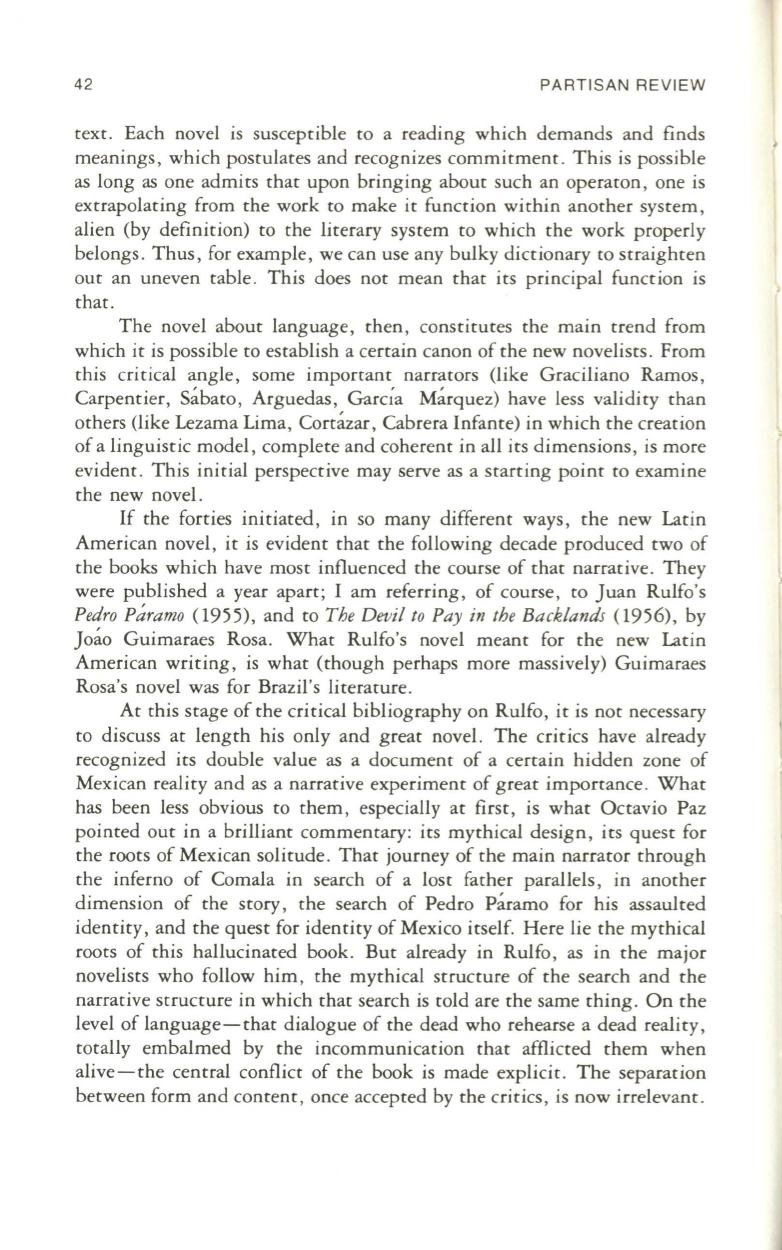
42
PARTISAN REVIEW
text . Each novel is susceptible to a reading which demands and finds
meanings, which postulates and recognizes commitment . This is possible
as long as one admits that upon bringing about such an operaton , one is
extrapolating from the work to make it function within another system ,
alien (by definition) to the literary system to which the work properly
belongs. Thus , for example, we can use any bulky dictionary to straighten
out an uneven table . This does not mean that its principal function is
that.
The novel about language, then, constitutes the main trend from
which it is possible to establish a certain canon of the new novelists . From
this critical angle, some important narrators (like Graciliano Ramos,
Carpentier, Sabato, Arguedas, Garcia Marquez) have less validity than
others (like Lezama Lima, Cortazar , Cabrera Infante) in which the creation
of a linguistic model, complete and coherent in all its dimensions, is more
evident . This initial perspective may serve as a starting point to examine
the new novel.
If the forties initiated, in so many different ways, the new Latin
American novel , it is evident that the following decade produced two of
the books which have most influenced the course of that narrative . They
were published a year apart; I am referring, of course, to Juan Rulfo's
Pedro Paramo
(1955), and to
The Devil to Pay in the Backlands
(1956), by
Joao Guimaraes Rosa. What Rulfo's novel meant for the new Latin
American writing, is what (though perhaps more massively) Guimaraes
Rosa's novel was for Brazil's literature .
At this stage of the critical bibliography on Rulfo, it is not necessary
to discuss at length his only and great novel. The critics have already
recognized its double value as a document of a certain hidden zone of
Mexican reality and as a narrative experiment of great importance . What
has been less obvious to them, especially at first, is what Octavio Paz
pointed out in a brilliant commentary: its mythical design, its quest for
the roots of Mexican solitude. That journey of the main narrator through
the inferno of Comala in search of a lost father parallels, in another
dimension of the story , the search of Pedro Paramo for his assaulted
identity, and the quest for identity of Mexico itself. Here lie the mythical
roots of this hallucinated book. But already in Rulfo, as in the major
novelists who follow him, the mythical structure of the search and the
narrative structure in which that search is told are the same thing. On the
level of language - that dialogue of the dead who rehearse a dead reali ty ,
totally embalmed by the incommunication that afflicted them when
alive-the central conflict of the book is made explicit. The separation
between form and content , once accepted by the critics, is now irrelevant .


